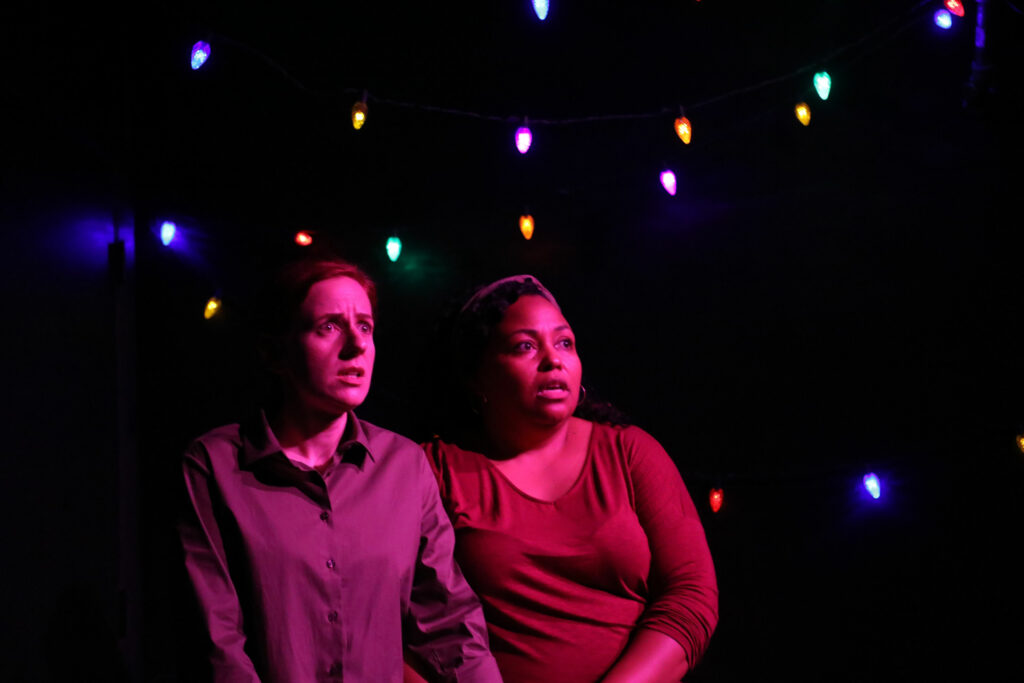BRIGHT HALF LIFE at Strand Theater Company
Theater Reviews Page | Previous Theater Review | Next Theater Review
BRIGHT HALF LIFE at Strand Theater Company

Posted on BroadwayWorld September 14, 2019
The Strand Theater Company is an impressive troupe. Working in what the marketplace would treat as a niche, women’s theater, and performing on a small stage in a neighborhood far from Baltimore’s commercial and artistic heart, Strand has survived for ten seasons, passing through at least three artistic directorships and a change of venue. Its shows give the appearance of being produced on a shoestring. And these adversities notwithstanding, based on Paula Vogel‘s And Baby Makes Seven (reviewed here in April) and now Tanya Barfield‘s Bright Half Life (premiered 2015), it’s clear the company is doing outstanding work.
Bright Half Life might be characterized as a love story (director Tony Korol-Evans calls it that, in her note in the program), though that label has its limitations, for reasons I won’t go into here for fear of uttering spoilers. It follows the relationship of Vicky (Ayesis Clay) and Erica (Katharine Vary) through 45 years, from their first encounter, when Erica applies for a job entering data in Vicky’s department of a financial sector company, through courtship, marriage and parenthood. Along the way, they (and hence we in the audience) must grapple with issues that come with those common human experiences plus additional ones raised by the fact that Erica is white and Vicky black, by the fact that Vicky is Erica’s work supervisor, by the fact that, both being women of their time, they are immediately confronting prejudice and only later in the relationship are legally able to marry – and in addition issues raised by the particularities of their personalities, like Erica’s acrophobia and Vicky’s somewhat undefined sexual orientation.
If this weren’t enough for the audience to chew on, the tale is presented in a totally nonsequential fashion, and at nearly breakneck speed much of the time. We are left to piece together the whole story from dozens of fragments that appear and pass quickly, which can be both exhausting and exhilarating. And not just for us in the audience; this calls for enormous flexibility on the part of the performers too. Moments of ecstasy are juxtaposed with moments of terror, joy and sadness arrive cheek-by-jowl, and certain incidents are repeatedly revisited. The two performers must be emotional quick-change artists, and I found myself amazed watching as Clay and Vary worked their way intrepidly through those changes. Blackout followed blackout, and after each one, the characters might be in a totally different time and place in their relationship from the one previously explored. And Clay and Vary were unfailingly right there. Highlights for me included Erica’s hilarious panic in a stopped Ferris wheel gondola (Vary’s delivery is priceless, and, fortunately for the audience, this scene is repeatedly returned to), and Vicky’s complicated and very human reaction at learning that Erica has received a job offer that carries the potential of upsetting the couple’s lives. All hail K. Tony Korol-Evans, as well, for direction that must have been intimately bound up with these tour-de-force performances.
My applause for how the play is performed does not quite dispose of the question of how important the play actually is. That something this exciting deserves to be performed goes without saying. (And it is performed; a brief internet search will reveal reviews of plenty of different stagings.) But is it more than exciting? I’m of two minds. Simply as a witness, as a representation of kinds of lives that have historically not been presented much on the stage, it arguably has considerable value. But, again avoiding spoilers, all it really says about these lives is that, like everyone else’s lives, they consist of good things and bad ones, and that, in a mortal world, there is a sadness that will follow all happiness. Is that enough? I don’t know.
What I do know is, this is a gem of an evening of theater, and should not be missed. Strand is to be commended for sticking to its guns and its mission (this season it is expanding its repertoire from four to six plays). And audiences should support it.
Copyright (c) Jack L. B. Gohn, except for production photo.
Photo credit: Shaelynn Jae Photography
Theater Reviews Page | Previous Theater Review | Next Theater Review